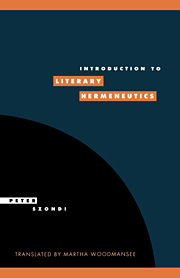Book contents
- Frontmatter
- Contents
- Foreword by Joel Weinsheimer
- Translator's preface
- Chapter 1 Introduction
- Chapter 2 Chladenius, I
- Chapter 3 Chladenius, II
- Chapter 4 Chladenius, III
- Chapter 5 Chladenius, IV
- Chapter 6 Meier, I
- Chapter 7 Meier, II
- Chapter 8 Ast
- Chapter 9 Schleiermacher, I
- Chapter 10 Schleiermacher, II
- Afterword by Jean Bollack
- Index
Chapter 9 - Schleiermacher, I
Published online by Cambridge University Press: 14 December 2009
- Frontmatter
- Contents
- Foreword by Joel Weinsheimer
- Translator's preface
- Chapter 1 Introduction
- Chapter 2 Chladenius, I
- Chapter 3 Chladenius, II
- Chapter 4 Chladenius, III
- Chapter 5 Chladenius, IV
- Chapter 6 Meier, I
- Chapter 7 Meier, II
- Chapter 8 Ast
- Chapter 9 Schleiermacher, I
- Chapter 10 Schleiermacher, II
- Afterword by Jean Bollack
- Index
Summary
In turning to Schleiermacher's hermeneutics, which underwent a number of modifications during a span of nearly three decades, from 1805 to 1833, let us employ some of the insights gained in our discussion of Ast, and by focusing on the areas in which he diverges from eighteenth-century hermeneutics, attempt to ascertain what Ast's and Schleiermacher's hermeneutic systems have in common and how they differ. The fact that Ast's system is shaped by the Identity philosophy of Schelling explains why his name was long forgotten in the history of hermeneutics while Schleiermacher, at least since Dilthey, has been considered the most important representative, even the founder, of philosophical hermeneutics. If this is an explanation, then it is not simply because Ast's theses stand or fall with the validity of Schelling's Identity philosophy, but because these philosophical premises do not so much formulate, or solve, the problems of hermeneutics as make them appear to have been already solved. Schleiermacher, by contrast, displays an extremely keen awareness of problems, as may be seen in the numerous modifications of his hermeneutic theory over the years.
Of course, the history of the development of Schleiermacher's hermeneutics has only recently become an object of scholarly investigation. Dilthey's image of Schleiermacher, and hence the image for the first six decades of our century (because Dilthey's authority on this matter was hardly questioned until 1959), is based on the hermeneutic texts contained in the edition of his Sämmtliche Werke [Complete Works] begun in the year of his death, 1834: the two Academy addresses of 1829 and Hermeneutik und Kritik [Hermeneutics and Criticism], edit by Friedrich Lücke on the basis of Schleiermacher's literary estate and notes on his lectures.
- Type
- Chapter
- Information
- Introduction to Literary Hermeneutics , pp. 109 - 120Publisher: Cambridge University PressPrint publication year: 1995

